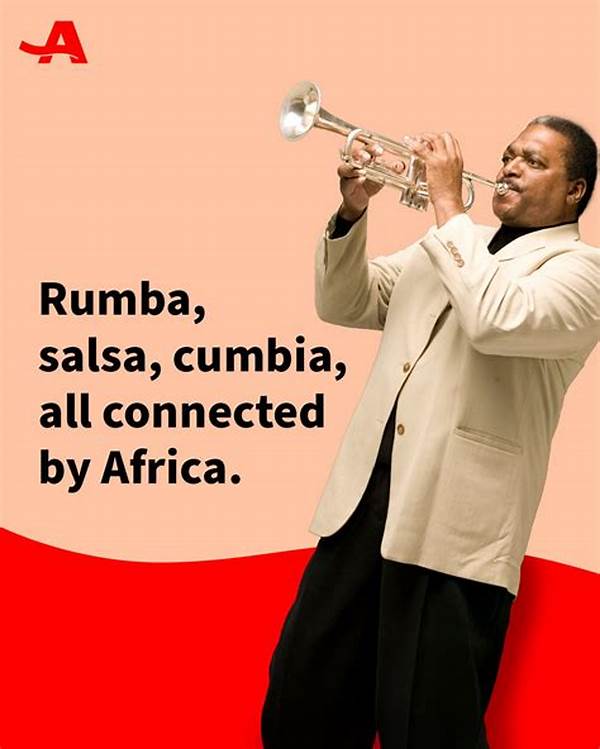Cumbia, one of Latin America’s most magnetic and spirited music genres, wouldn’t have the soul-stirring charm it boasts today without the powerful influence of African rhythms. This vibrant genre, which irresistibly lures dancers to their feet, has deep roots anchored in African drumbeats and traditions. Unbeknownst to many, the heart-thumping rhythms that permeate cumbia reveal a historical narrative of resilience and cultural fusion. Dive headfirst into these intoxicating beats, and you’ll soon realize that cumbia’s pulse is intertwined with African heartbeat—a symbiotic relationship that brings joy and connection.
Read Now : “must-have Tracks For Club Djs”
Tracing Back the Threads
Let’s take it back and explore how African rhythms weave into cumbia’s fabric. Picture this: a time when enslaved Africans and indigenous communities shared stories, dances, and, of course, beats. The influence of African rhythms in cumbia is undeniable and has shaped its essence. African percussion instruments, such as drums and marimbas, laid the foundation for cumbia’s unique sound, adding a layer of richness and emotion to the music. These beats were not just to entertain; they were a method of communication, a means of preserving cultures across borders. Today, those rhythms echo through speakers and dance halls around the world, proving that African rhythms are the lifeblood of cumbia’s compelling cadence. The magic of cumbia, just like a cool breeze, is both refreshing and deeply rooted.
Beats that Keep on Beatin’
1. The influence of African rhythms in cumbia gives it that spicy groove that just makes you wanna shake what your mama gave you.
2. African drumbeats transformed cumbia into a party starter, ensuring the good vibes keep rolling all night long.
3. Ever noticed how cumbia’s rhythms are contagious? That’s African influence making it impossible to sit still.
4. African rhythms brought the syncopation into cumbia – it’s where the music lives and breathes.
5. Catch that bassline? The influence of African rhythms in cumbia makes it deep, rich, and straight up irresistible.
Rhythmic Fusion
Imagine walking through a bustling market with brightly colored stalls, vibrant music echoing from all corners, and a rhythm that pulls you in. That’s the influence of African rhythms in cumbia, painting a picture of life, energy, and movement. African slaves, having been forcefully brought to South America, used music as a form of resistance and cultural expression. Those rhythmic patterns blossomed into cumbia, as African drumbeats mingled with indigenous sounds. And just like that, a genre that tells the story of the past and moves the future was born—fresh, rhythmic, and alive.
Read Now : Top Merengue Artists 2023
Cumbia wouldn’t be cumbia without those African rhythms that add an intoxicating flavor. Picture this scenario: you’re learning the dance steps, feeling the beat in your bones, and suddenly you’re transported back in time, connected to centuries of history. The influence of African rhythms in cumbia is not just historical; it’s a testament to survival, to joy, and an invitation to partake in a dance as old as time. Let those drumbeats guide your moves, my friend, and let’s honor the roots that brought this music to life.
Reviving the Beats
African rhythms aren’t just an influence on cumbia—they are its heartbeat. The infectious energy of cumbia comes directly from African rhythms. Their beats and syncopation make cumbia a universal groove, transcending borders. It doesn’t matter if you’re in a New York club or a Colombian plaza; once those rhythms hit, you’re on a dance floor thousands of miles wide. The influence of African rhythms in cumbia elevates the music to an experience, a celebration, a nod to our common ancestry and shared histories.
When the African rhythm meets the unique vibe of cumbia, it’s a match made in dance heaven. With every beat, we’re reminded of the cultural harmony that these rhythms call forth. The sound of the drums speaks volumes of unity and strength, captivating every step and sway. The influence of African rhythms in cumbia turns music into a dialogue, spanning continents and centuries. The exhilarating drumsticks may rest, but the vibrations continue on.
Echoes of the Past
African rhythms, baby, they make cumbia what it is – rhythmically rich, full of life and history. When those beats hit, it’s like a sonic time machine, taking us back to when cultures blended to create something utterly divine. The influence of African rhythms in cumbia isn’t just a contribution; it’s the backbone of every note, driving the tempo and pace. When the soul of African drums infuses with melodies, it’s a whirlwind of sound that just doesn’t quit – it keeps everyone locked in rhythm, across ages and phases, a pulsating heartbeat that echoes through time, uniting people in a collective groove.
When you’re chillin’ at a party or having a laid-back evening, and suddenly cumbia steals the airwaves, you can’t help but move. It’s that African vibe intertwined with cumbia making you forget your worries, making you groove like no one’s watching. The influence of African rhythms in cumbia transports mind and soul to the roots, to a celebration of unity, of music’s power to transcend and embrace. Let those drums speak, and let their rhythms guide you through a dance that’s older than time and as fresh as a new sunrise.
